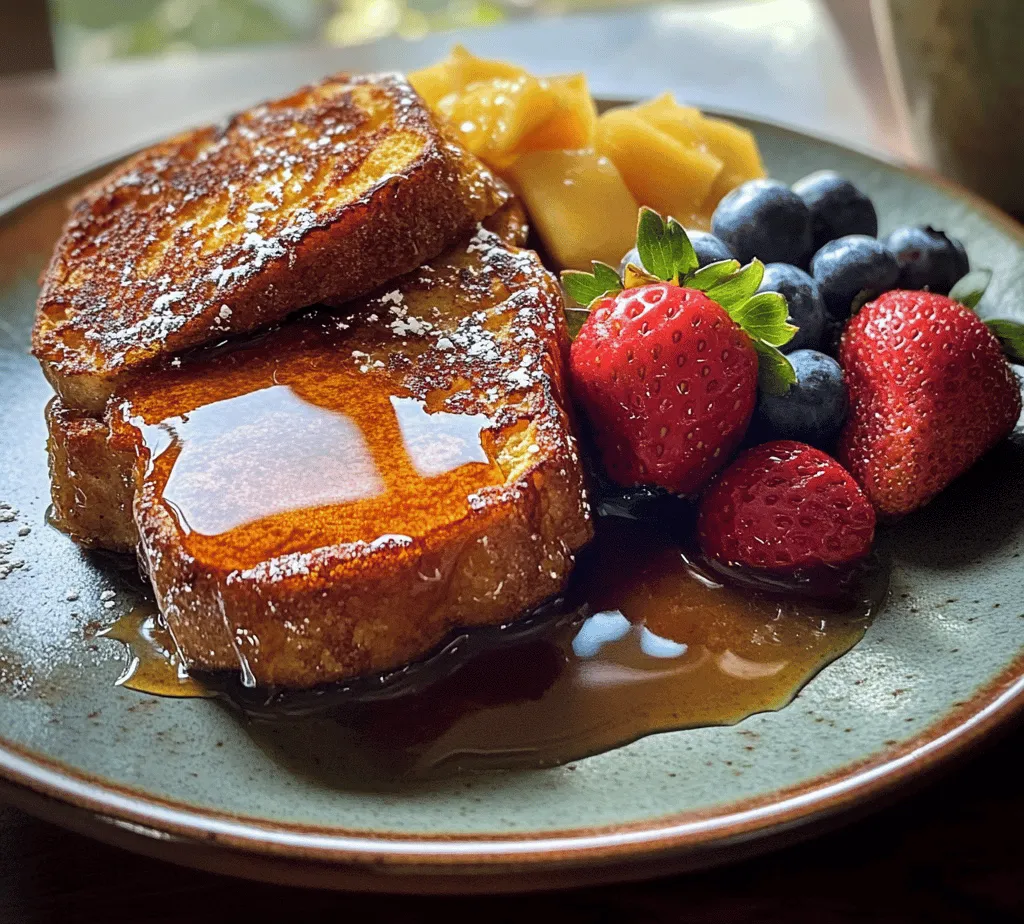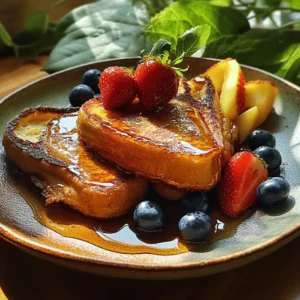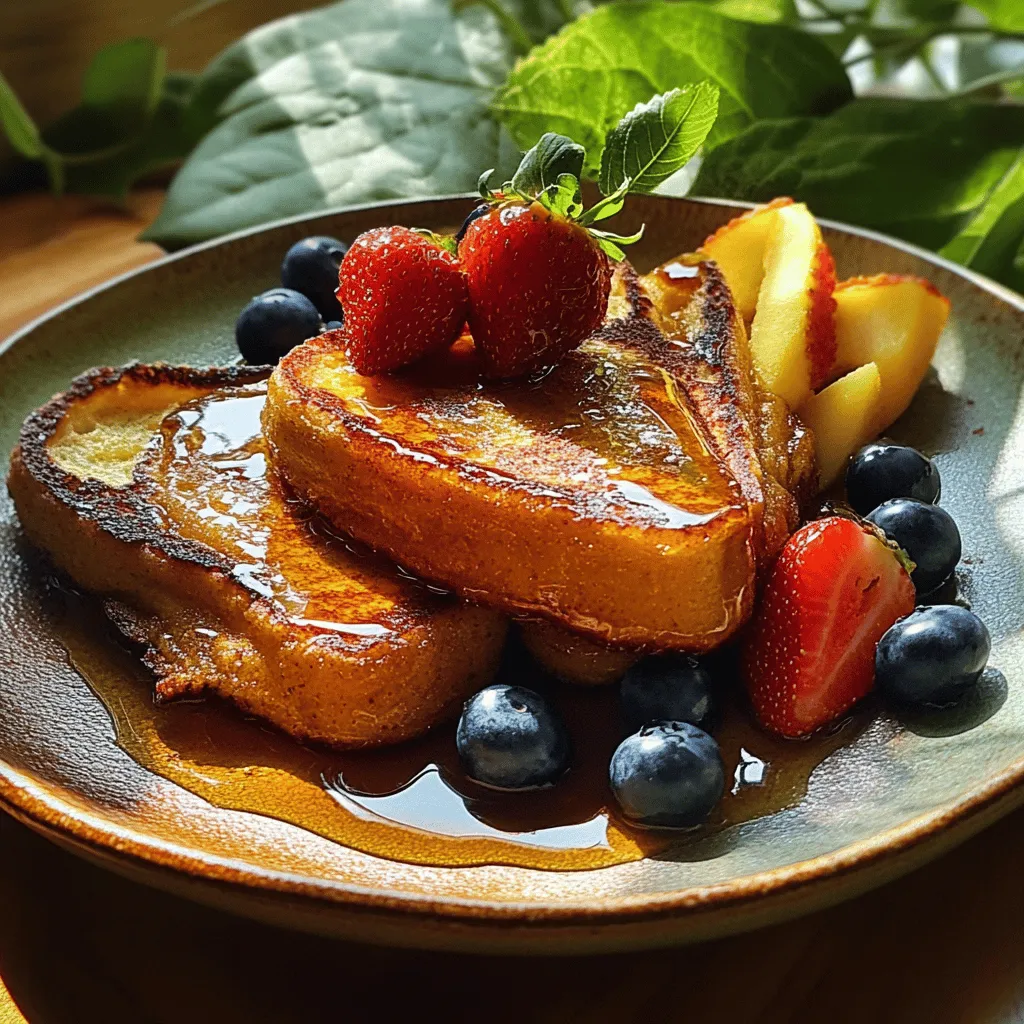Introduction
French toast is a beloved breakfast dish that has captured the hearts and taste buds of people around the world. Originally created as a way to use up stale bread, this dish has evolved into a breakfast staple, enjoyed in various forms across different cultures. Whether served plain or dressed up with toppings, its versatility makes it a favorite among families and individuals alike. Among the many variations of French toast, caramelized French toast stands out with its unique flavor profile that combines the classic taste of French toast with the rich, sweet notes of caramelization.
The concept of caramelized French toast is simple yet indulgent. By allowing the sugar to develop a deeper flavor through caramelization, this dish transforms into a luxurious breakfast experience that tantalizes the palate. Best of all, this recipe is designed to be easy and quick to prepare, making it an ideal choice for busy mornings when you want to indulge without spending hours in the kitchen. The comforting aroma of French toast cooking on the stove is sure to entice anyone nearby, inviting them to join in on the deliciousness.
In this article, we will guide you through the process of making easy caramelized French toast, highlighting the steps, ingredients, and techniques that elevate this classic dish. Whether you’re a seasoned cook or a novice in the kitchen, this recipe is accessible and rewarding, promising to deliver a delightful breakfast for you and your loved ones.
Understanding French Toast
To appreciate caramelized French toast fully, it’s helpful to understand the history and variations of this timeless dish. French toast, known as “pain perdu” in France, translates to “lost bread.” The name refers to the practice of reviving stale bread by soaking it in a mixture of eggs and milk, then frying it until golden brown. This age-old technique not only prevents food waste but also creates a deliciously satisfying meal that can be enjoyed any time of the day.
Over the years, French toast has seen numerous adaptations, varying from country to country. In the United States, it is often served topped with syrup, powdered sugar, or fresh fruit, while in other cultures, it may be flavored with spices or enjoyed with savory accompaniments. The versatility of French toast is one of the reasons it remains popular in households worldwide.
When it comes to caramelized French toast, there are some key differences in the ingredients used. While traditional recipes typically rely on simple ingredients like eggs, milk, and bread, this caramelized version introduces brown sugar as a primary component. The use of thick slices of bread, such as brioche or challah, is also critical in achieving the desired texture and flavor. These types of bread are richer and denser than standard sandwich bread, allowing them to absorb the egg mixture without becoming too soggy.
The Allure of Caramelization
One of the defining features of caramelized French toast is the process of caramelization itself. Caramelization occurs when sugar is heated, causing it to melt and transform into a rich, golden syrup. This process not only enhances the sweetness of the dish but also adds a complex depth of flavor and an irresistible texture. When you cook the French toast in a mixture that includes brown sugar, the sugar caramelizes on the surface, creating a crispy, slightly crunchy exterior that contrasts beautifully with the soft, fluffy interior.
Using brown sugar in this recipe is particularly crucial, as it contains molasses, which contributes to the overall flavor and color of the caramel. The natural sweetness of brown sugar pairs perfectly with the other ingredients, enhancing the indulgent experience of each bite. Additionally, the heat applied during cooking is essential for achieving the caramelized effect; it transforms the sugars and proteins in the bread and egg mixture, resulting in a beautifully cooked piece of French toast.
Ingredients Breakdown
To prepare easy caramelized French toast, you’ll need the following ingredients:
Thick Bread
The foundation of any good French toast is the bread, and for caramelized French toast, thick varieties like brioche or challah work best. These breads are soft, buttery, and have a slightly sweet flavor, making them ideal for soaking up the egg and milk mixture. Using thick slices ensures that the bread holds up during cooking, allowing for a golden crust while maintaining a tender interior.
Eggs
Eggs play a critical role in binding the ingredients together and enriching the dish. They provide structure and create a custard-like texture when combined with milk. The eggs also contribute to the beautiful golden color and help achieve that signature French toast flavor.
Whole Milk
Whole milk is preferred in this recipe for its creamy consistency, which adds richness to the egg mixture. The creaminess of whole milk complements the other ingredients, resulting in a decadent and satisfying French toast. If you prefer a lighter version, you can substitute with lower-fat milk, but keep in mind that it may alter the final texture.
Vanilla Extract and Cinnamon
These two ingredients are essential for enhancing the aroma and flavor of the French toast. Vanilla extract adds a warm, sweet note that elevates the overall taste, while cinnamon introduces a comforting spice that pairs beautifully with the sweetness of caramelized sugar. Together, they create a fragrant and inviting dish.
Butter
Butter is crucial for cooking the French toast and adds a rich flavor. It not only prevents the toast from sticking to the pan but also helps create that coveted golden-brown crust. Using high-quality unsalted butter ensures that you can control the saltiness of the dish, allowing the sweetness of the caramel to shine through.
Brown Sugar
As the star ingredient responsible for the caramelization, brown sugar brings a deep sweetness and a hint of molasses flavor to the French toast. When heated, it melts and creates a delightful caramelized crust that enhances the dish’s appeal. Opting for light or dark brown sugar will subtly alter the flavor, with dark brown sugar providing a more robust taste.
Maple Syrup and Fresh Fruit
While the caramelized French toast can stand alone, serving it with maple syrup and fresh fruit adds an extra layer of flavor and presentation. Maple syrup provides a classic accompaniment, enhancing the sweetness of the dish, while fresh fruit—such as berries, bananas, or slices of peaches—adds freshness and a pop of color. These toppings not only make the dish visually appealing but also introduce new textures and flavors that complement the caramelized French toast beautifully.
With these ingredients at your disposal, you’re well on your way to creating a delicious and comforting breakfast that will have everyone coming back for seconds. In the following sections, we will guide you through the step-by-step process of making easy caramelized French toast, ensuring that you achieve the perfect balance of flavors and textures. Stay tuned for the detailed instructions that will take your breakfast game to the next level.

Step-by-Step Instructions
Making the perfect caramelized French toast involves a series of thoughtful steps that ensure a delicious outcome. Follow these detailed instructions to create a breakfast that’s both delightful and satisfying.
Whisking the Egg Mixture
Start by whisking together your eggs, milk, sugar, vanilla extract, and a pinch of salt in a large mixing bowl. The importance of thorough mixing cannot be overstated; you want to achieve a uniform consistency that allows the flavors to meld beautifully. Ensure that the egg yolks and whites are fully combined, creating a rich, creamy base that will coat your bread evenly.
Preparing the Skillet
While you prepare the egg mixture, place a skillet or griddle over medium heat. This is crucial—if your skillet is too hot, the outside of the French toast will burn before the inside cooks through. Conversely, if it’s not hot enough, you won’t achieve that desirable golden caramelization. A good test for the skillet’s readiness is to sprinkle a few drops of water onto the surface; if they dance and evaporate quickly, your skillet is set for cooking.
Add a tablespoon of butter to the skillet. Let it melt completely, swirling it around to coat the surface evenly. This not only adds flavor but also helps prevent the toast from sticking.
The Soaking Technique
Once your skillet is ready, it’s time to soak the bread. Dip each slice of bread into the egg mixture, ensuring both sides are well-coated. However, here’s the key: do not let the bread soak for too long, as it can become overly soggy. A quick dip—just a few seconds on each side—should suffice. The goal is to achieve a perfect balance of moisture without compromising the structural integrity of the bread.
Cooking Tips
After soaking, gently place the slices on the skillet. Cook for about 3-4 minutes on one side, or until you see a golden-brown hue developing. Look for visual cues: the edges should slightly firm up and the bottom should be caramelized. When it’s time to flip, use a spatula to carefully lift the toast; if it resists, give it another minute. Once flipped, let the other side cook for another 3-4 minutes until it matches the golden color of the first side.
For an extra touch of caramelization, you can sprinkle a bit of sugar on top of the French toast right before flipping. This will create a delightful crispy crust.
Serving Suggestions
Presentation can elevate your caramelized French toast from delicious to extraordinary. Here are some creative ideas:
– Layered with Fresh Fruits: Top your French toast with sliced bananas, strawberries, or blueberries. The natural sweetness and acidity of the fruit complement the rich caramelized flavor beautifully.
– Drizzled with Maple Syrup: A classic choice, but consider warming the syrup slightly before drizzling to enhance its flavor.
– Whipped Cream: A dollop of freshly whipped cream can add a light and airy texture to your plate.
– Nuts for Crunch: Sprinkle toasted nuts like pecans or almonds over the top for added crunch and nutrition.
– Garnish with Mint Leaves: A few fresh mint leaves can add a pop of color and a refreshing flavor contrast.
Nutritional Considerations
While caramelized French toast is a delightful treat, understanding its nutritional content can help you enjoy it in balance. Generally, one serving (two slices) contains approximately 350-450 calories, depending on the type of bread and toppings used. It provides a good source of protein and carbohydrates while also containing fats from the butter.
For those with dietary restrictions, there are a few modifications you can consider:
– Dairy-Free Alternatives: Use almond milk, coconut milk, or oat milk in place of regular milk for a dairy-free version. For the butter, opt for coconut oil or vegan butter.
– Bread Choices: Whole grain or gluten-free bread can be used to make this recipe more nutritious. Sourdough or brioche can also provide unique flavors and textures.
– Sugar Substitutes: For a lower-sugar option, consider using a sugar substitute or reducing the amount of sugar in the egg mixture.
Creative Variations
Experimenting with different ingredients can take your caramelized French toast to new heights. Here are some suggestions:
– Different Breads: Use challah, brioche, sourdough, or even a hearty multigrain bread. Each type will lend a distinct texture and flavor profile to the dish.
– Flavored Extracts: Enhance the egg mixture with different extracts such as almond, orange, or hazelnut for a new twist. A sprinkle of cinnamon or nutmeg can also add warmth and depth.
– Toppings Beyond the Norm: Try incorporating toppings like Greek yogurt, honey, or a drizzle of chocolate sauce. You could also create a savory version with ricotta and sautéed spinach.
Pairing Suggestions
To create a well-rounded breakfast experience, consider pairing your caramelized French toast with complementary beverages and side dishes.
– Beverages: A hot cup of coffee or freshly brewed tea pairs wonderfully with French toast. For a refreshing option, a glass of freshly squeezed orange juice or a fruit smoothie can provide a bright contrast to the richness of the toast.
– Side Dishes: Serve with crispy bacon or sausage for a savory balance. Alternatively, a yogurt parfait with granola and berries can add a refreshing touch.
Conclusion
Making and enjoying caramelized French toast is a joyful experience that brings together simple ingredients for a delicious breakfast. The satisfaction of creating it from scratch is unmatched, and the flavor combinations are endless.
Feel free to experiment with the recipe, adapting it to suit your tastes and preferences. Whether you choose to keep it classic or add your unique twist, the pleasure of homemade breakfast will always remain. So gather your ingredients, invite family or friends, and indulge in this delightful dish that promises to make any morning special. Enjoy every bite and the simple pleasure that comes from cooking something delicious!



